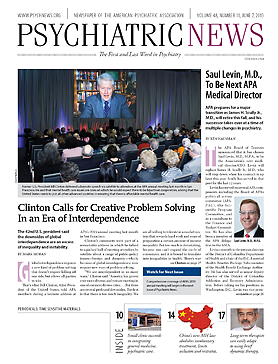The treatment for posttraumatic stress disorder (PTSD) best supported by evidence is exposure therapy, as the Institute of Medicine reported in 2007. In controlled therapeutic circumstances, exposure leads to extinction of fear associated with the original trauma.
“Extinction is new learning that generates an alternative, safe memory,” said Gregory Quirk, Ph.D., at the Eighth Annual Conference on the Amygdala, Stress, and PTSD, April 23 at the Uniformed Services University of the Health Sciences in Bethesda, Md.
“Extinction of fear memories is a clinically important mechanism, but extinction does not erase the fear memory,” said Quirk, a professor of psychiatry and an adjunct professor of anatomy and neurobiology at the University of Puerto Rico. “Both fear and safety memories are present after extinction, and they compete for which is retrieved.”
Clinicians use exposure-based therapy to convince the brain that the patient’s life is not in danger, but deficiencies in extinction can impair response in the clinic to exposure-based treatments, he said.
To explore the workings of extinction, Quirk has tested in rats the effects of electrical and chemical inputs to selected areas of the brain.
Fear decreases when electrical stimulation is applied to the infralimbic area but increases when applied to the prelimbic area.
Deep brain stimulation (DBS) applied to the dorsal area of the ventral striatum in rats reduced fear and strengthened extinction. Stimulation of the ventral area of the striatum produced the opposite effect, increasing fear and reducing extinction.
DBS in the same region in humans has been shown to lessen symptoms of obsessive-compulsive disorder (OCD) and depression, said Quirk. “That suggests that facilitation of extinction is one way that DBS is working in OCD and depression.”
Chemical experiments using the GABA agonist muscinol show that the infralimbic area is needed for learning extinction and the prelimbic area for fear expression, he said.
More intriguing, injection of brain-derived neurotrophic factor (BDNF) into the infralimbic cortex seems to replace extinction training. BDNF is both necessary and sufficient for extinction. “BDNF appears to induce extinction on its own,” he said. “It’s not just turning off the amygdala, but it makes the neurons think that extinction has taken place.”
PTSD patients normally extinguish fear but fail to recall that extinction the next day, suggesting deficits in the prefrontal cortex and the hippocampus.
During extinction, the amount of BDNF in the hippocampus is increased. The hippocampus supplies BDNF to the prelimbic cortex, and in PTSD hippocampus volume is reduced, so perhaps BDNF serves as a kind of control, he suggested.
“The hippocampus supplies BDNF to the PFC, but in PTSD, the hippocampal volume is reduced so maybe that reduces BDNF control,” he said.
In a paper in the June 1 Biological Psychiatry, Quirk and colleagues reported that patients with PTSD with the Met-66 allele of BDNF had a poorer response to exposure therapy than patients with the Val/Val allele.
While exposure is one way to minimize the conditioned cues that trigger fear responses in mice or humans, another is its opposite, avoidance. But avoidance of stimuli associated with trauma is a key symptom of PTSD.
In the clinic, avoidance brings short-term comfort at the expense of long-term inactivation of the fear. “The problem is that if you don’t come into contact with fear stimuli, you can’t develop extinction,” said Quirk. “Avoidance reduces opportunities for normal extinction. Exposure hurts, but we have to teach the brain: ‘You did survive.’ ” ■
More on the Amygdala, Stress, and PTSD Conference and the Center for the Study of Traumatic Stress at the Uniformed Services University is posted at
http://amygdalaconference.org/.

